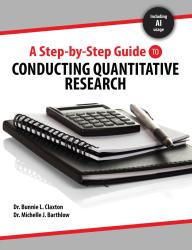A Step-by-Step Guide to Conducting Quantitative Research
Author(s): Bunnie Loree Claxton , Michelle Barthlow
Edition: 1
Copyright: 2024
Pages: 320
Edition: 1
Copyright: 2024
Pages: 320
Choose Your Format
Choose Your Platform | Help Me Choose
A Step-By-Step Guide to Conducting Quantitative Research features a thorough explanation of frequently used quantitative designs and statistics in social science research. The guide assists in selecting the appropriate design and statistic and provides model write-ups of rationales for each design and statistic. Additional models are provided for writing up results of statistical analyses.
This title is part of a Step-By-Step book series designed to teach teach the novice researcher how to write a dissertation using quantitative data collection and analysis strategies. This approach guides the educator through the entire research process from developing a research topic to presenting a final manuscript.
Every edition includes a step-by step-approach to conducting research using a template. This series of books includes a detailed explanation of each step, examples of each step, videos to further understanding, chapter highlights to reinforce critical information, and quiz bank questions to assess understanding. This book will lead the researcher through the research process in an educational setting from commencement to culmination.
Chapter 1: Introduction to Quantitative Research
Introduction
Quantitative Research Defined
Quantitative Research Designs
Reasons to Conduct Quantitative Research
Steps to Conduct Quantitative Research
Conclusion
Chapter Highlights
Chapter 2: How to Write the Front Matter
Introduction
Outline of a Quantitative Research Manuscript
How to Write the Front Matter
How to Write the Title Page
How to Write the Signature Page
How to Write the Abstract
How to Write the Table of Contents
How to Write the Copyright Page
How to Write the Dedication Page
How to Write the Acknowledgments Page
How to Write the List of Tables
How to Write the List of Figures
How to Write the List of Abbreviations
Conclusion
Chapter Highlights
Chapter 3: How to Write Chapter 1: Introduction
Introduction
How to Write the Overview
How to Write the Background
How to Write the Problem Statement
How to Write the Purpose Statement
How to Write the Significance of the Study
How to Write Quantitative Research Questions
How to Write the Identification of Variables
How to Write the Definitions
How to Write the Summary
Conclusion
Chapter Highlights
Chapter 4: How to Write Chapter 2: Literature Review
Introduction
How to Analyze and Synthesize Scholarly Literature
Steps to Compose a Literature Review
How to Write a Literature Review Outline
How to Write a Literature Review
How to Write the Overview
How to Write the Theoretical Framework
How to Write the Related Literature
How to Write a Summary
Conclusion
Chapter Highlights
Chapter 5: How to Write Chapter 3: Method
Introduction
How to Write the Overview
How to Write the Research Design Section
Quantitative Research Question(s) and Null Hypothesis(es)
Setting and Participants
How to Write the Setting and Participants Section
Instrumentation
Theoretical Blueprint of the Instrument
How to Write the Instrumentation Section
Procedures
How to Write the Procedures Section
Data Analysis Plan
How to Write the Data Analysis Plan Section
Summary
How to Write the Summary Section
Conclusion
Chapter Highlights
Chapter 5: Addendum
Addendum 5A
Addendum 5B
Addendum 5C
Addendum 5D
Chapter 6: How to Write Chapter 4: Results
Introduction
How to Write the Overview
How to Write the Research Question(s) and Null Hypothesis(es)
How to Write the Results
How to Determine If the Null Hypothesis Is Rejected or Failed to Be Rejected
How to Write the Summary
Conclusion
Chapter Highlights
Chapter 6: Addendum
Addendum 6A
Addendum 6B
Chapter 7: How to Write Chapter 5: Discussion
Introduction
How to Write the Overview
How to Write the Discussion
How to Write the Limitations
How to Write the Recommendations for Future Research
How to Write the Conclusion
Summary
Conclusion
Chapter Highlights
Chapter 8: How to Defend Your Research
Introduction
The Presentation
The Proposal Defense
The Final Defense
Chapter 9: How to Publish Your Research
Introduction
How to Transform Your Dissertation into a Manuscript for Publication
Steps to Publish Your Research
Conclusion
Chapter Highlights
Chapter 10: How to Generate Content Using AI in Doctoral Research
Introduction to Artificial Intelligence (AI) in Doctoral Research
AI Defined
The Purpose of AI in Doctoral Research
How to Generate Content Using AI
Steps to Generate Content Using AI
How to Use Content Generated by AI
Limitations of AI in Education
AI and Ethical Considerations
Conclusion
Chapter Highlights
Chapter 11: Quantitative Research Dissertation Template
Appendix A: Individual Scholarly Works Template
Appendix B: Comparative Scholarly Works Template
Glossary
References
Index
Dr. Bunnie L. Claxton is the founder and chief executive officer of Dissertation Research Specialist, a company that supports the implementation of doctoral programs in universities around the world. She currently serves as a consultant to universities regarding dissertation research to assist with program development, course development, and faculty training. She also provides support to doctoral candidates through her website www.dissertationspecialist.com. She is an adjunct instructor, subject matter expert, and dissertation chair for multiple universities. She is an international speaker, and she presented her research at Oxford University and Cambridge University in 2025. She was the keynote speaker for the World Conference on Teaching and Education in Berlin, Germany. Formerly, she served as the director of applied doctoral research at Liberty University. Dr. Claxton has been involved in the field of education since 1994, including public school, private school, home school, and higher education. Dr. Claxton served as the superintendent for Liberty University Online Academy, an online K–12 school with over 16,000 students, and she currently serves on the board of directors. She is the author of 20 textbooks and is best known for her Step-by-Step textbook series. A few titles include A Step-by-Step Guide to Conducting Applied Research, A Step-by-Step Guide to Conducting Qualitative Research, A Step-by-Step Guide to Conducting Quantitative Research, A Step-by-Step Guide to Writing a Literature Review for Doctoral Research, and A Step-by-Step Introduction to Research Methods: Qualitative, Quantitative, Mixed-Methods, and Applied.
A Step-By-Step Guide to Conducting Quantitative Research features a thorough explanation of frequently used quantitative designs and statistics in social science research. The guide assists in selecting the appropriate design and statistic and provides model write-ups of rationales for each design and statistic. Additional models are provided for writing up results of statistical analyses.
This title is part of a Step-By-Step book series designed to teach teach the novice researcher how to write a dissertation using quantitative data collection and analysis strategies. This approach guides the educator through the entire research process from developing a research topic to presenting a final manuscript.
Every edition includes a step-by step-approach to conducting research using a template. This series of books includes a detailed explanation of each step, examples of each step, videos to further understanding, chapter highlights to reinforce critical information, and quiz bank questions to assess understanding. This book will lead the researcher through the research process in an educational setting from commencement to culmination.
Chapter 1: Introduction to Quantitative Research
Introduction
Quantitative Research Defined
Quantitative Research Designs
Reasons to Conduct Quantitative Research
Steps to Conduct Quantitative Research
Conclusion
Chapter Highlights
Chapter 2: How to Write the Front Matter
Introduction
Outline of a Quantitative Research Manuscript
How to Write the Front Matter
How to Write the Title Page
How to Write the Signature Page
How to Write the Abstract
How to Write the Table of Contents
How to Write the Copyright Page
How to Write the Dedication Page
How to Write the Acknowledgments Page
How to Write the List of Tables
How to Write the List of Figures
How to Write the List of Abbreviations
Conclusion
Chapter Highlights
Chapter 3: How to Write Chapter 1: Introduction
Introduction
How to Write the Overview
How to Write the Background
How to Write the Problem Statement
How to Write the Purpose Statement
How to Write the Significance of the Study
How to Write Quantitative Research Questions
How to Write the Identification of Variables
How to Write the Definitions
How to Write the Summary
Conclusion
Chapter Highlights
Chapter 4: How to Write Chapter 2: Literature Review
Introduction
How to Analyze and Synthesize Scholarly Literature
Steps to Compose a Literature Review
How to Write a Literature Review Outline
How to Write a Literature Review
How to Write the Overview
How to Write the Theoretical Framework
How to Write the Related Literature
How to Write a Summary
Conclusion
Chapter Highlights
Chapter 5: How to Write Chapter 3: Method
Introduction
How to Write the Overview
How to Write the Research Design Section
Quantitative Research Question(s) and Null Hypothesis(es)
Setting and Participants
How to Write the Setting and Participants Section
Instrumentation
Theoretical Blueprint of the Instrument
How to Write the Instrumentation Section
Procedures
How to Write the Procedures Section
Data Analysis Plan
How to Write the Data Analysis Plan Section
Summary
How to Write the Summary Section
Conclusion
Chapter Highlights
Chapter 5: Addendum
Addendum 5A
Addendum 5B
Addendum 5C
Addendum 5D
Chapter 6: How to Write Chapter 4: Results
Introduction
How to Write the Overview
How to Write the Research Question(s) and Null Hypothesis(es)
How to Write the Results
How to Determine If the Null Hypothesis Is Rejected or Failed to Be Rejected
How to Write the Summary
Conclusion
Chapter Highlights
Chapter 6: Addendum
Addendum 6A
Addendum 6B
Chapter 7: How to Write Chapter 5: Discussion
Introduction
How to Write the Overview
How to Write the Discussion
How to Write the Limitations
How to Write the Recommendations for Future Research
How to Write the Conclusion
Summary
Conclusion
Chapter Highlights
Chapter 8: How to Defend Your Research
Introduction
The Presentation
The Proposal Defense
The Final Defense
Chapter 9: How to Publish Your Research
Introduction
How to Transform Your Dissertation into a Manuscript for Publication
Steps to Publish Your Research
Conclusion
Chapter Highlights
Chapter 10: How to Generate Content Using AI in Doctoral Research
Introduction to Artificial Intelligence (AI) in Doctoral Research
AI Defined
The Purpose of AI in Doctoral Research
How to Generate Content Using AI
Steps to Generate Content Using AI
How to Use Content Generated by AI
Limitations of AI in Education
AI and Ethical Considerations
Conclusion
Chapter Highlights
Chapter 11: Quantitative Research Dissertation Template
Appendix A: Individual Scholarly Works Template
Appendix B: Comparative Scholarly Works Template
Glossary
References
Index
Dr. Bunnie L. Claxton is the founder and chief executive officer of Dissertation Research Specialist, a company that supports the implementation of doctoral programs in universities around the world. She currently serves as a consultant to universities regarding dissertation research to assist with program development, course development, and faculty training. She also provides support to doctoral candidates through her website www.dissertationspecialist.com. She is an adjunct instructor, subject matter expert, and dissertation chair for multiple universities. She is an international speaker, and she presented her research at Oxford University and Cambridge University in 2025. She was the keynote speaker for the World Conference on Teaching and Education in Berlin, Germany. Formerly, she served as the director of applied doctoral research at Liberty University. Dr. Claxton has been involved in the field of education since 1994, including public school, private school, home school, and higher education. Dr. Claxton served as the superintendent for Liberty University Online Academy, an online K–12 school with over 16,000 students, and she currently serves on the board of directors. She is the author of 20 textbooks and is best known for her Step-by-Step textbook series. A few titles include A Step-by-Step Guide to Conducting Applied Research, A Step-by-Step Guide to Conducting Qualitative Research, A Step-by-Step Guide to Conducting Quantitative Research, A Step-by-Step Guide to Writing a Literature Review for Doctoral Research, and A Step-by-Step Introduction to Research Methods: Qualitative, Quantitative, Mixed-Methods, and Applied.




